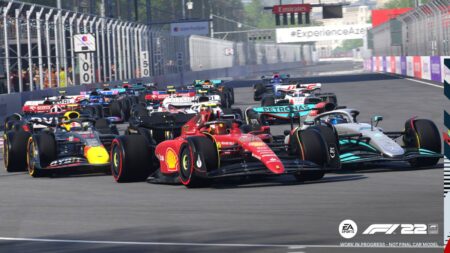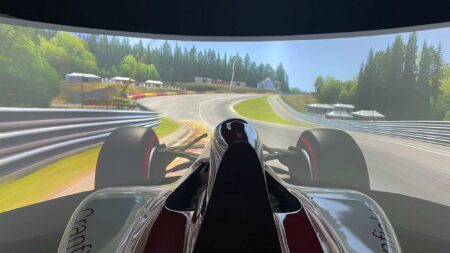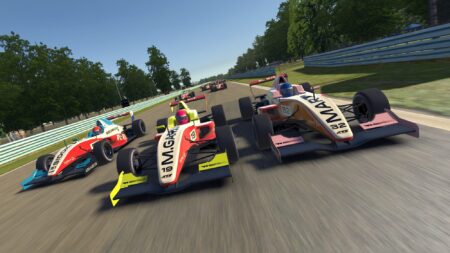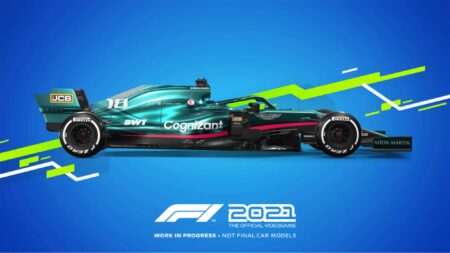
F1 22 review: new generation of cars brings fresh challenges for gamers
A new era of F1 cars, complete challenges in supercars and VR compatible are key features for this year's game and more
Does 2018 off-road racing game Gravel live up to Sega Rally’s legacy or match the success of the Dirt series?

Gravel’s aim is to emulate the heights of Sega Rally’s much-loved off-road racing success. Yet this seems to fall flat with a clunky presentation, but beneath that there’s still something to enjoy.
Developed by Milestone, the now-experienced Italian developer has produced games such as the MotoGP series, the Ride series, WRC and the World Rallycross Championship games, so Gravel is a casual breakaway from its usual licenced fare.
Given that WRC 7 was an altogether tighter affair than its predecessors, though not at the standard of the Colin McRae Rally games, a rallycross-based departure for Milestone seems a logical idea, considering the success of the Dirt series and the inclusion of rallycross in iRacing, Project Cars 2 and Gran Turismo Sport.
There’s no pretence of simulation here; the game starts you off on a fictional track in Alaska before whisking you away to Namibia, the Outback, Mont Blanc and a handful of other trails.
The career mode takes you through those fictional locations and real-life tracks such as rallycross mainstay Lohéac, Euro NASCAR destination Franciacorta and Latvian racetrack Biķernieki where you take part in rallycross races, checkpoint races, time attacks and a couple more variations on the formula. At various stages through the game’s career mode, you take on stars (caricature-like villains) of the ‘Gravel Channel’ in head-to-head races.
Racing is a calamitous affair due to the nature of the AI, which refrains from sliding through corners or straying too far from the racing line. The competitors’ braking points are far too early as well, making Turn 1 rear-enders common, and collisions likely. That’s when Gravel’s physics show their ugly side: get airborne on one of the litany of jumps dotted around the game’s circuits and your car will invariably become light as a feather, and, in many cases, end up flipping and rolling comically through the dirt.
Back on the ground, the driving model is solid and firmly in arcade territory, with slides easy to catch and maintain. A driving rhythm is generated before too long, bounding through corners and shifting the weight of the car seamlessly. The handling model isn’t difficult to master, and on the wheel we used – the Thrustmaster T150 – force-feedback is well-imagined, if a bit inconsistent and forgiving. Ruts and dirt dynamically form on the surface and bumps translate themselves well through the wheel, some of the time. Unfortunately, there’s no way to change steering-wheel settings. If you’re inclined towards using a controller, Gravel works well on any pad.
There are a handful of technical issues with the game, with dipping frame-rates bringing the game to a halt on the stock Xbox One (but not as much on the Playstation 4) quite frequently. Graphics seem a touch more polished on the PS4 as well, though the game never shines as much as Codemasters’ Dirt series. Notably, water effects firmly belong in the mid-2000s rather than the present day, and damage is rudimentary – flip a car seven times and it will end up looking just a bit worse for wear, and there’s a good chance it’ll run like new.
The engines lack the punch needed when it comes to stadium trucks and rally cars, with sounds tinny, though there are the usual pops and crackles and thuds when it comes to collisions. It’s a missed opportunity, considering that the car list features some left-field vehicles not seen in many other games of this genre.
That car list is the standout feature. A usual rallycross roster is included, such as the Ford Fiesta and Volkswagen Beetle, but the host of Group B rally cars, raid vehicles and oddities inject some much-needed personality into Gravel. The 1987 Toyota MR2 222D, 2013 Suzuki Grand Vitara, 2015 Toyota Land Cruiser and rally-spec Abarth 124 are such welcome inclusions that it becomes puzzling why other games haven’t included such a varied, characterful selection of cars. They’re stifled somewhat by the handling model, but shows that the developers have spent a fair few hours scouring the history books and picking their line-up – a reassuring trait.
Turn off the grating rock music in the background – what seems to be a single music track – skip the cutscenes and mute the pre-race announcer, and you have a serviceable arcade racing title with an enticing selection of cars and an interesting array of environments. The racing, importantly, can be downright enjoyable, but it ranges from that to being slightly monotonous, and apart from the career mode, a standard multiplayer mode (no split-screen) and the option to time trial, there’s nothing much in the way of replay value. Perhaps the promise of new tracks and downloadable cars – some of which are already available, such as the Porsche Rally Pack – will lengthen its lifespan.
As a result, Milestone’s ambitions to revive an arcade-racing genre in need of kindling with a bright new title haven’t been fully realised with Gravel.

A new era of F1 cars, complete challenges in supercars and VR compatible are key features for this year's game and more

Born from military technology and turned into a Formula 1 simulator, AXSIM has turned it into a sim for your own home

Esports has long been viewed as insignificant but 'old views' need to change according to some drivers

Formula 1 will get its first story mode as part of its official video game with the release of F1 2021. The announcement trailer teased the new 'Braking Point' story…